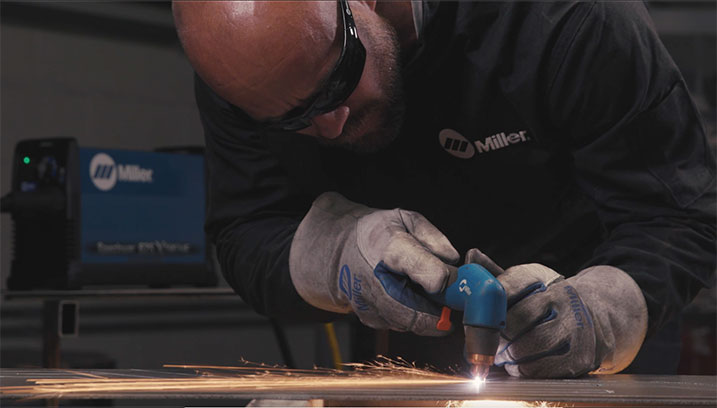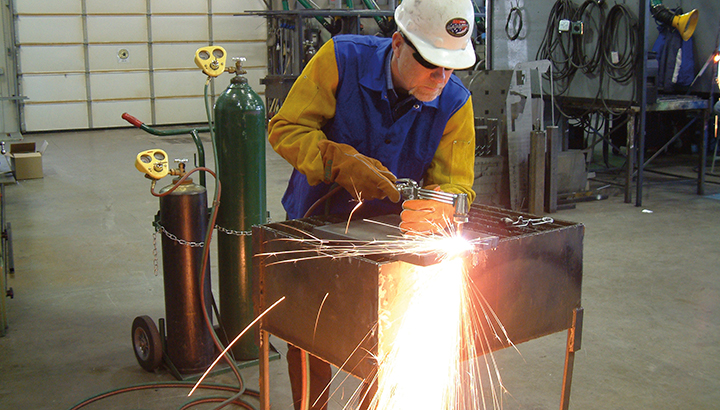Oxy-fuel torch vs. plasma cutter
Many welding jobs involve a metal cutting step, whether in the fabrication shop or on a jobsite.
Two popular metal-cutting processes are plasma arc and oxy-fuel cutting. Both systems have advantages and disadvantages, so determining the best fit depends on numerous factors, including the type and thickness of the metal being cut, location of the job, power resources available and cost.
Oxy-fuel torches have long been a popular choice for cutting metal in the field due to portability benefits. However, technology advancements are making plasma a more portable option. Learn more about the basics of each process and factors to consider in choosing one for your application.
Plasma cutting basics

Plasma is an ionized gas that conducts electricity, created by adding energy to an electrically neutral gas. The energy is electricity and the gas is typically compressed air. Both elements combine in a chamber between an electrode and nozzle, causing the gas to become imbalanced, creating plasma gas. Air pressure forces the plasma gas through the nozzle, creating a concise constricted flow that is electrically conductive. The more energy added via the plasma cutter, the hotter the plasma arc becomes, providing more cutting capacity and efficiency.
Operations use plasma cutters for cutting and gouging, with the average hand-held system capable of cutting a maximum metal thickness of about 1 inch. Plasma typically requires a source for compressed air and electrical power. These are issues to consider when the application requires portability, though the reduced size and weight of plasma machines — with some smaller machines weighing about 20 pounds — make them a more portable option than ever. Also, the need for electrical power is not an issue on many jobsites, where engine-driven welder/generators are commonly available.
Advantages of plasma cutters
- Ability to cut many types of metals. Plasma cutters can cut non-ferrous metals such as aluminum, stainless steel and cast iron.
- Cutting precision. Plasma typically cuts quickly and with minimal slag, providing smooth cuts with a narrower kerf than what oxy-fuel torches produce.
- No preheating required: Because plasma doesn’t require preheating the metal before cutting, this saves time and money.
- Faster speeds on thinner metals. Plasma can cut thinner metals faster than oxy-fuel can, and with minimal or no metal distortion. Plasma also offers better performance when cutting stacked metals.
- Better cutting on shaped metals. When the workpiece has angles, channels or tubes, plasma cutting can provide faster and more precise cutting performance.
- Ease of use. Plasma systems are relatively simple to use compared to oxy-fuel systems and provide the benefit of minimal cleanup.
- Safety benefits. Plasma systems don’t require storing or handling explosive gases or dealing with an open flame.
Oxy-fuel cutting basics

With oxy-fuel cutting, an oxygen/fuel gas flame preheats the steel to its ignition temperature. A high-powered oxygen jet is then directed at the metal, creating a chemical reaction between the oxygen and the metal to form iron oxide, also known as slag. The high-powered oxygen jet removes the slag from the kerf.
When using oxy-fuel torches, the type of fuel gas used may influence cut quality, preheating times and metal thicknesses. Cutters most frequently use four basic fuel gases in combination with oxygen for this process: acetylene, propane, propylene and natural gas. Operations typically choose fuel gases according to the cutting application, cost, heat output and oxygen consumption.
Benefits of oxy-fuel cutting
- Good for thicker metals: The average hand-held oxy-fuel system can cut steel 6 to 12 inches thick, with some systems capable of cutting steel more than 20 inches thick. For thicker steels of more than 1 inch, oxy-fuel torches are capable of greater cutting speeds when compared to typical 100-amp hand-held plasma cutting systems.
- Great portability: For cutting in the field, oxy-fuel systems provide a high degree of portability since they don’t require electrical power. Some small oxy-fuel systems weigh about 35 pounds, so with oxy-fuel tanks and a torch, it is possible to cut steel almost anywhere.
- Extended lengths available: Oxy-fuel torches are available in extended lengths to keep the operator at a distance from the heat, flames and slag produced while cutting. Most torch hoses are connected to a set of cylinders on a portable cart or sometimes to a stationary manifold header system. The use of long hoses allows greater portability.
- Process versatility: Oxy-fuel torches can cut, weld, braze, solder, heat and gouge.
However, there are several factors to keep in mind regarding oxy-fuel cutting systems.
Operations normally use oxy-fuel torches for cutting only ferrous metals or those containing iron, such as carbon steel. For the most part, they are not used for cutting cast iron, aluminum or stainless steel.
And while oxy-fuel torches aren’t dependent on primary power or compressed air, they do require purchase of gas.
Consider the uses
Cost considerations likely also will come into play when making the decision between an oxy-fuel torch vs. a plasma cutter. The initial investment in a plasma cutter is typically more expensive than an oxy-fuel system. However, oxy-fuel torches involve an ongoing cost for the necessary gases, which plasma cutters don’t require.
When choosing between plasma and oxy-fuel cutting tools, ask yourself: what metal do I cut most often, and what is the thickest metal I will cut? If the job consistently requires cutting thicker metals, the time and money saved by quickly cutting through thick metal with an oxy-fuel system makes a difference. On the flip side, if precision cutting of stainless steel and aluminum is important, a plasma system is the way to go.
The bottom line: Oxy-fuel torches and plasma cutters have a place in most metal-processing applications, and many operations will benefit from having both systems in their arsenal.